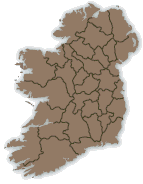Tháinig lá breá samhraidh - Róise Nic Cumhaill
Recording: [Download audio file]
[Download AIFF audio file (of processed ‘user’ version)]
[Download AIFF audio file (of archive version)]
Transcript
Ó, agus tháinig lá breá samhraidh agus bhí mé ar an mhargadh,
Is iomaí duine a deir, "Is trua gan tú sa bhaile agam."
Is ara Mhuire mhó,
Is ara Mhuire mhara arú,
Is ara Mhuire mhó,
An dtiocfaidh tú nó an bhfanfaidh tú?
Ó, agus rachaidh mé go Glenties is leanfaidh trup abhaile mé.
Is ara Mhuire mhó,
Is ara Mhuire mhara arú,
Is ara Mhuire mhó,
An dtiocfaidh tú nó an bhfanfaidh tú?
Ó, agus gheall mo ghrá beag féin go dtiocfadh sé go siúráilte.
Is ara Mhuire mhó,
Is ara Mhuire mhara arú,
Is ara Mhuire mhó,
An dtiocfaidh tú nó an bhfanfaidh tú?
Translation
Oh, and there came a fine summer's day and I was at the fair,
And many people say, "It's a pity I don't have you at home with me."
And oro Mary mo,
And oro Mary mara aroo,
And oro Mary mo,
Will you come or will you stay?
Oh, and I will go to Glenties and a crowd will follow me home (?).
And oro Mary mo,
And oro Mary mara aroo,
And oro Mary mo,
Will you come or will you stay?
Oh, and my own little love promised that he would surely come.
And oro Mary mo,
And oro Mary mara aroo,
And oro Mary mo,
Will you come or will you stay?
Commentary
This is a version of the popular Donegal children's love song 'A Stór, a Stór, a Ghrá'. Other Donegal versions appear in Seán Ó Baoighill, Réamonn Ó Frighil and Aodh Ó Duibheannaigh, Cnuasacht de cheoltaí Uladh (Newry, 1944), 16-17; Cumann an Ógra, Abair amhrán (Belfast, 1962), 34; Seán Óg and Mánus Ó Baoill, Ceolta Gael (Cork, 1975), 16; and Pádraigín Ní Uallacháin, A Stór ’s a stóirín (Gael-Linn, Dublin, 1994), 21-2. Recordings of the song include: Tríona Ní Dhomhnaill, Tríona (Gael-Linn, 1975); Pádraigín Ní Uallacháin, A stór ’s a stóirín (Gael-Linn, 1994); Altan, Blackwater (Virgin Records, 1996); Tríona Ní Dhomhnaill, Maighréad Ní Dhomhnaill, Máiréad Ní Mhaonaigh and Moya Brennan, T with the Maggies (TWM Music, 2010). The repetitive lyrics and formulaic structure of the song make it ideally suited to lúibíní or ceapóga, namely extempore verse. It may be related in this regard to songs such as 'Is Óró Mhíle Grá' (see Seán Ó Morónaigh, Agallaimh na hÉigse: cíoradh agus cnuasach (Camus, 2010), 56-9, 531-45) and 'Óró Mhór a Mhóirín' (see David Cooper, The Petrie collection of the ancient music of Ireland (Cork, 2002), 149-51), which were traditionally used for entertainment by groups of young women engaged in repetitive work such as spinning.
Title in English: There came a fine summer's day
Digital version published by: Doegen Records Web Project, Royal Irish Academy
Description of the Recording:
Speaker:
Róise
Nic Cumhaill from Co.
Donegal
Person who made the recording:
Karl Tempel
Organizer and administrator of the recording scheme: The Royal Irish Academy
In collaboration with: Lautabteilung, Preußische Staatsbibliothek (now Lautarchiv,
Humboldt-Universität zu Berlin)
Recorded on 01-10-1931 at 11:00:00 in
Courthouse, Letterkenny. Recorded on 01-10-1931 at 11:00:00 in
Courthouse, Letterkenny.
Archive recording (ID LA_1242d2, from a shellac disk stored at the
Royal Irish Academy) is 00:34 minutes
long. Archive recording (ID LA_1242d2, from a shellac disk stored at the
Royal Irish Academy) is 00:34 minutes
long.
Second archive recording (ID LA_1242b2, from a shellac disc stored in
Belfast) is 00:34 minutes long. Second archive recording (ID LA_1242b2, from a shellac disc stored in
Belfast) is 00:34 minutes long.
User recording (ID LA_1242d2, from a shellac disk stored at the Royal
Irish Academy) is 00:33 minutes long. User recording (ID LA_1242d2, from a shellac disk stored at the Royal
Irish Academy) is 00:33 minutes long.





